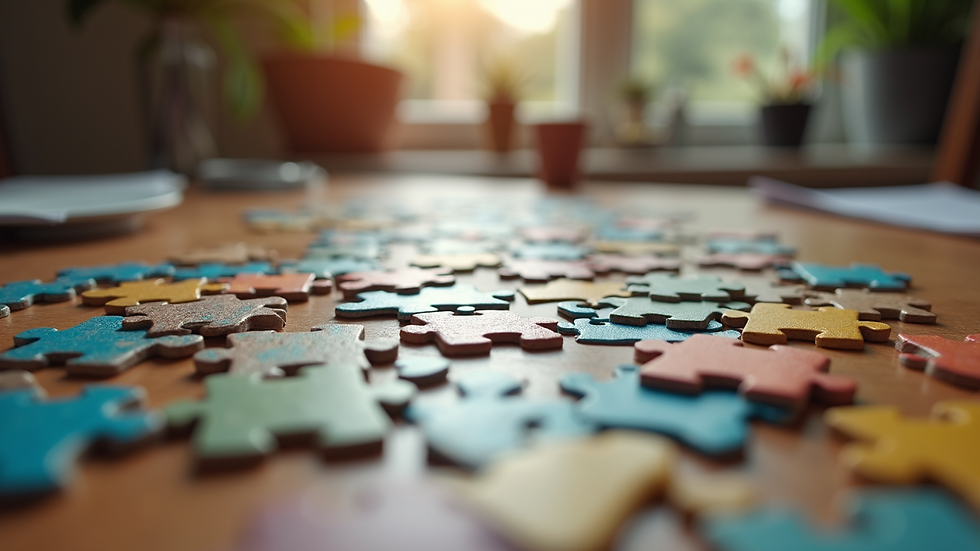Exploring the World of Jigsaw Puzzles
- lslatt20001
- Nov 3
- 3 min read
Jigsaw puzzles offer more than just a pastime. They challenge the mind, encourage patience, and provide a satisfying sense of accomplishment. Whether you are a casual puzzler or a dedicated enthusiast, the world of jigsaw puzzles holds endless fascination. This post explores the history, benefits, types, and tips for enjoying jigsaw puzzles, helping you discover why they remain popular across generations.

The Origins of Jigsaw Puzzles
Jigsaw puzzles began in the 18th century as educational tools. Originally, they were maps glued onto wood and cut into pieces to teach geography. Over time, the puzzles evolved into entertainment, with images ranging from landscapes to famous artworks.
The name "jigsaw" comes from the saw used to cut the pieces. Early puzzles were handmade, making each one unique. Today, machines produce puzzles with precision, allowing for thousands of pieces and complex designs.
Why People Enjoy Jigsaw Puzzles
Jigsaw puzzles appeal to a wide audience for several reasons:
Mental challenge: Puzzles require problem-solving skills, pattern recognition, and spatial reasoning.
Stress relief: Focusing on a puzzle can calm the mind and reduce anxiety.
Social activity: Many people enjoy working on puzzles with family or friends.
Sense of achievement: Completing a puzzle provides a clear goal and reward.
Research shows that puzzles can improve memory and cognitive function, especially in older adults. They also encourage mindfulness by keeping attention focused on the present moment.
Different Types of Jigsaw Puzzles
Jigsaw puzzles come in many forms, catering to different skill levels and interests.
By Piece Count
Small puzzles: 100 to 300 pieces, suitable for beginners or children.
Medium puzzles: 500 to 1000 pieces, offering a moderate challenge.
Large puzzles: 2000 pieces or more, designed for experienced puzzlers.
By Image Theme
Nature scenes: Forests, oceans, animals.
Art reproductions: Famous paintings or modern art.
Cityscapes: Skylines, landmarks, street views.
Fantasy and abstract: Creative or surreal images.
By Material and Style
Traditional cardboard puzzles: Most common and affordable.
Wooden puzzles: Durable and often handcrafted.
3D puzzles: Pieces form three-dimensional objects like buildings or globes.
Double-sided puzzles: Two images on opposite sides for extra challenge.
How to Choose the Right Puzzle
Selecting a puzzle depends on your preferences and experience level. Here are some tips:
Start simple if you are new, with fewer pieces and clear images.
Pick themes you enjoy to stay motivated.
Consider the size of the puzzle and the space available for assembly.
Look for quality puzzles with well-cut pieces that fit snugly.
Tips for Assembling Jigsaw Puzzles
Working on a puzzle can be more enjoyable and efficient with a few strategies:
Sort pieces by edge, color, or pattern before starting.
Build the border first to create a frame.
Work on small sections based on distinct colors or shapes.
Use good lighting to see details clearly.
Take breaks to avoid frustration and maintain focus.
Storing and Displaying Completed Puzzles
Once finished, you might want to preserve or display your work:
Glue and frame the puzzle to hang on a wall.
Use puzzle mats to roll up and store unfinished puzzles.
Take photos before disassembling to remember the image.
Donate or trade puzzles to share the fun with others.
The Community Around Jigsaw Puzzles
Puzzling has a strong community online and offline. Puzzle clubs, forums, and social media groups allow enthusiasts to share tips, photos, and recommendations. Some events and competitions celebrate speed and skill in puzzle assembly.
The Future of Jigsaw Puzzles
Technology influences puzzles with digital apps and augmented reality versions. Still, the tactile experience of physical puzzles remains unmatched for many. New designs and themes continue to attract diverse audiences, ensuring puzzles stay a beloved activity.
Jigsaw puzzles combine challenge, creativity, and relaxation in one activity. Whether you want to sharpen your mind, unwind after a busy day, or connect with others, puzzles offer a rewarding experience. Try starting with a small puzzle today and discover the joy of fitting the pieces together.


Comments